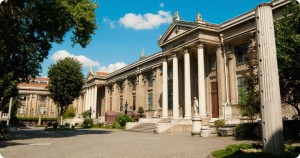My recommendations of places to visit in Istanbul..
The Blue Mosque
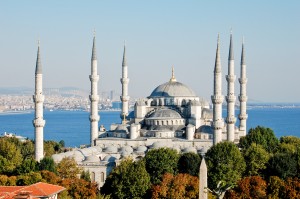 The Blue Mosque is covered with glazed tiles in blue, green and reddish brown. That blue tiles are placed quite high so it isn’t immediately clear why the mosque got its name. However, it is an impressive building, a worthy Islamic answer to the Hagia Sofia.
The Blue Mosque is covered with glazed tiles in blue, green and reddish brown. That blue tiles are placed quite high so it isn’t immediately clear why the mosque got its name. However, it is an impressive building, a worthy Islamic answer to the Hagia Sofia.
The Blue Mosque of Istanbul, also called the mosque of Sultan Ahmet, is the Islamic answer to the Hagia Sofia. The architect Mehmet Aga Sedefkâr wanted to surpass the grandeur of those Christian-Orthodox Church and according to some, he achieved this. The Blue Mosque was built between 1609 and 1617, almost 1100 years after the completion of the Hagia Sofia.
Sultanahmet Meyd, Istanbul
Hagia Sofia
 It’s hard to imagine that this magnificent construction work already in the 6th century. Moreover, there was a mistake in the construction. After more than 20 years, the original dome in. The responsible architects had to forfeit the death.
It’s hard to imagine that this magnificent construction work already in the 6th century. Moreover, there was a mistake in the construction. After more than 20 years, the original dome in. The responsible architects had to forfeit the death.
Emperor Justinian in the 6th century gave order to start the construction of the Hagia Sophia (Holy wisdom), after an earlier Church on that place at a rebellion against his rule was devastated. At the official opening of the new church would Justinian have proclaimed: “Solomon, I have outdone you!” Originally, the Hagia Sofia a Christian-Orthodox Church, later turned into a mosque.
Aya Sofya Meyd, Istanbul
Topkapi Palace
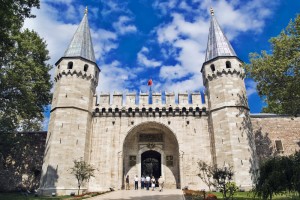 In the Topkapi Palace you can imagine how the sultans lived. It is a vast complex with indoor gardens and pavilions. Most appeals to the imagination a tour of the harem, where the 400 women of the sultan resided.
In the Topkapi Palace you can imagine how the sultans lived. It is a vast complex with indoor gardens and pavilions. Most appeals to the imagination a tour of the harem, where the 400 women of the sultan resided.
The original Topkapi Palace was built in the mid 15th century by sultan Mehmet II. In the following centuries, the Palace was extended by various sultans to eventually accommodate some 5000 people: the sultan and his family, the harem and the servants.
Gülhane Park, Sultanahmet, Eminönü, Istanbul
The Grand Bazaar
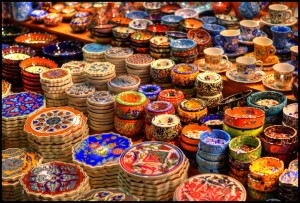 To get a true impression of the Turkish life you have to visit the Grand Bazaar. A tangle of streets, thousands of shops and even more people. You can name it, it’s there for sale.
To get a true impression of the Turkish life you have to visit the Grand Bazaar. A tangle of streets, thousands of shops and even more people. You can name it, it’s there for sale.
The Grand Bazaar (Kapali Çarsi, literally covered market) is the largest market of Istanbul with thousands of shops, restaurants and cafes. This market is also an idea of sultan Mehmet the Conqueror, who had built the bazaar in the 15th century. In 1954, a large part of the market was destroyed by fire, but soon afterwards rebuilt. It is a labyrinth of corridors where people jostle to do some shopping. Paths along the greater focus a lot on tourists shops, wander around and go so close to the real side-passages in Turkish atmosphere. That sniff you must take literally, because the bazaar smells like everything from herbs, spices, fruit, kebab and leather goods, mixed with the sweat of the visitors.
Yeniçeriler Cad and Fuatpasa Cad, Istanbul
Boat trip on the Bosphorus
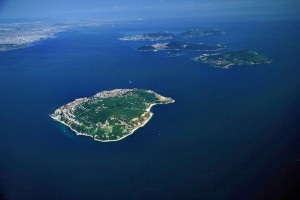 To escape from the hustle and bustle of Istanbul and see the sights of another point of view is a boat trip on the Bosphorus is a must. You can also go a little further, to the Princes islands where rebellious princes were beheaded.
To escape from the hustle and bustle of Istanbul and see the sights of another point of view is a boat trip on the Bosphorus is a must. You can also go a little further, to the Princes islands where rebellious princes were beheaded.
The boats leave from the port between The Galata bridge and the Sirkeci station. The end point of the ordinary ferries and the faster boats is Anadolu Kavagi TurYol. If you take the regular ferry it takes three hours, you must wait for the retreat, in an hour and a half with the TurYol back at The Galata bridge.
The boats leave throughout the day
Suleymaniye Mosque
 Sultan Süleyman was nicknamed ‘ the Magnificent ‘ and nowhere is that more evident than in his mosque which was built by master architect Sinan. Both are buried there. In the mosque is a bath house that you still can visit.
Sultan Süleyman was nicknamed ‘ the Magnificent ‘ and nowhere is that more evident than in his mosque which was built by master architect Sinan. Both are buried there. In the mosque is a bath house that you still can visit.
The architect of sultan Süleyman the Magnificent was one named Sinan. He has hundreds of buildings in Istanbul to his name, but his most famous work is the Suleiman Mosque which he built in the mid 16th century. Here lies buried not only the sultan, but – in a small outbuilding-also the architect. Further are the later sultans Suleiman II and Ahmed II buried there.
Sultan Süleyman loved everything that looked nice and expensive, but that did not mean that he had no attention for the poor population. On the contrary, within the Mosque complex he left a hospital, a bath house, a soup kitchen and some schools. Also travellers could stay in the mosque if they wanted to. The soup kitchen (Darüzziyafe) is nowadays a restaurant specializing in traditional Turkish cuisine. The Hammam still functions, it’s the only mixed bath house in Istanbul.
Gülhane Park, Istanbul
The Archaeological Museum
The Archaeological Museum (Arkeoloji Müzesi) consists of three museums: the archaeological finds are in the complex next to the Museum of the ancient Middle East (Eski Sark Eserleri Müzesi) and the Tiled Pavilion (Çinili Köskü).
The oldest objects are exhibited in the Museum of the ancient Middle East. You look for objects of the Egyptians and the Hittites. Interesting are the ancient clay tablets, including one with the world’s oldest peace treaty in Cuneiform.
The archaeological Department is dedicated to Greek and Roman times, with many pictures that have been found during excavations in Anatolia.
Gülhane Park, Istanbul
Egyptian Bazaar
 The Egyptian Bazaar is also known as the Spice bazaar (Misir Çarsisi) and is smaller than the great Bazaar, but it seems like there are more people walking around. This bazaar was built in the 17th century to generate revenue for the Yeni mosque. Then it was one large pharmacy, where herbal potions and other means of public health care were sold. Many herbs and spices were shipped from India via Egypt to Istanbul, hence the name.
The Egyptian Bazaar is also known as the Spice bazaar (Misir Çarsisi) and is smaller than the great Bazaar, but it seems like there are more people walking around. This bazaar was built in the 17th century to generate revenue for the Yeni mosque. Then it was one large pharmacy, where herbal potions and other means of public health care were sold. Many herbs and spices were shipped from India via Egypt to Istanbul, hence the name.
Those medicinal shops are still there, but the majority consists of shops with large bags full of brightly colored kitchen herbs, spices, dried fruits, nuts and other food items. So many places the famous Ant sweet candy Turkish delight (lokum) buy. And, Yes, also tulip bulbs are there for sale. Since this is originally a Turkish plant.
West of the Egyptian Bazaar is a maze of streets, which is also nice to explore. Also there you will find many herbal shops, but also household items and a flower market.
Sabunchani Sok, Eminönü, on the South side of The Galata bridge, Istanbul
Hippodrome and Yerebatan Sarayi
 The old Byzantine Hippodrome was not only the Centre of sportss but also from the political life. There’s not much left. Though there are the Egyptian obelisk of Theodosius (Dikilitas), the column of Constantine (Örme Sütun) and the snakes column (Yilanli Sütun) from the Greek Delphi, of which the snake heads incidentally disappeared. The Hippodrome in 532 was the scene of a bloody beating. After the so-called Nika riots against his rule the Emperor Justinian left 30000 insurgents here to slaughter.
The old Byzantine Hippodrome was not only the Centre of sportss but also from the political life. There’s not much left. Though there are the Egyptian obelisk of Theodosius (Dikilitas), the column of Constantine (Örme Sütun) and the snakes column (Yilanli Sütun) from the Greek Delphi, of which the snake heads incidentally disappeared. The Hippodrome in 532 was the scene of a bloody beating. After the so-called Nika riots against his rule the Emperor Justinian left 30000 insurgents here to slaughter.
On the north side of the Hippodrome is the entrance to an underground drinking water reservoir, which could contain up to 80000 cubic meters of water. It was built under Emperor Justinian and was the collecting basin for water coming from the mountains north of Istanbul, it was argued. There are more of these water basins in Istanbul, meant to have clean drinking water as the city was under siege, but this is one of the most beautiful.
Hippodrome, Sultanahmet Meyd, Istanbul
Museum of Turkish and Islamic art
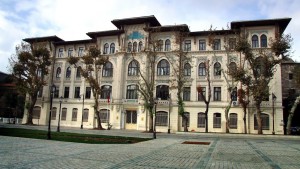 The Museum of Turkish and Islamic art (Türk-Islam Eserleri Müzesi) is located in the 16th century palace of Ibrahim Pasha. Ibrahim was the brother-in-law of sultan Süleyman. When Ibrahim got to much power as Grand vizier, Süleyman beheaded him.
The Museum of Turkish and Islamic art (Türk-Islam Eserleri Müzesi) is located in the 16th century palace of Ibrahim Pasha. Ibrahim was the brother-in-law of sultan Süleyman. When Ibrahim got to much power as Grand vizier, Süleyman beheaded him.
The museum has a magnificent collection of art objects, from the 8th century until the collapse of the Ottoman Empire at the beginning of the 20th century. The emphasis is on the Ottoman art with carpets, richly illustrated korans, sculptures, calligraphies, glass, porcelain and finely decorated lamps.
Very interesting are the reconstructed shelters of different walks of life. So you see there is a fully equipped nomad tent, but also a sitting room of a wealthy family in Ottoman times.
Atmeydani 46, Sultanahmet, Istanbul

